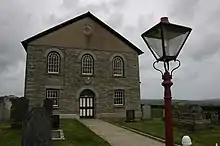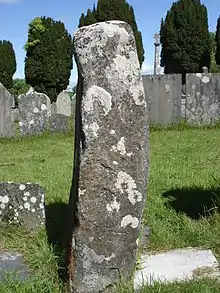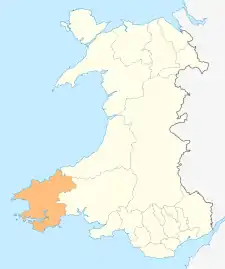Cilgerran
Cilgerran (previously Kilgerran or Cil-Garon) is a village, parish, community, and formerly an incorporated market town. It is situated on the south bank of the River Teifi in Pembrokeshire, Wales.
| Cilgerran | |
|---|---|
.jpg.webp) Parish Church of St Llawddog | |
 Cilgerran Location within Pembrokeshire | |
| Population | 1,507 (2011)[1] |
| OS grid reference | SN195427 |
| Community |
|
| Principal area | |
| Ceremonial county | |
| Country | Wales |
| Sovereign state | United Kingdom |
| Post town | CARDIGAN |
| Postcode district | SA43 |
| Dialling code | 01239 |
| Police | Dyfed-Powys |
| Fire | Mid and West Wales |
| Ambulance | Welsh |
| UK Parliament | |
| Senedd Cymru – Welsh Parliament | |
Among Cilgerran's attractions are Cilgerran Castle and annual coracle races. Kilgerran Halt was a stop on the former Whitland and Cardigan Railway. There are a number of listed buildings, including the parish church.
Nearby are the hamlets of Llwyncelyn, Rhoshill, Cnwce, Pen-y-bryn, Carreg-wen and Pontrhydyceirt, and the villages of Llechryd and Boncath.
Cilgerran Hundred derives its title from the former town,[2] which was once the headquarters of the commote of Emlyn is Cuch (Emlyn below the River Cuch).
Slate quarrying was an important activity in the 19th century.
Location
Cilgerran lies 50 metres (160 ft) above sea level on the southern bank of the River Teifi. The stream Afon Plysgog which rises on nearby Rhoshill runs under the road to the west of Cilgerran to join the Teifi. A mixture of woodland and pasture surrounds the town, which is strung out along a fairly level C-class road in an east–west orientation connecting with the A484 at Llechryd to the east and the A478 at Pen-y-bryn to the west.
History

Cilgerran Castle, strategically built in 1100 at "Cenarth Bychan", high above the River Teifi, is the castle from which Owain of Powys is said to have abducted Nest in 1109. Originally in Cantref Emlyn (Emlyn Is-Cych), Cilgerran came under Norman control with the building of the castle, from where the Lordship of Cilgerran was administered. The Welsh under the Lord Rhys regained control from 1164-5 (the date of the first recording of the name "Cilgerran"[3]) to 1223. By 1204 the town was beginning to grow, with 22 taxpayers recorded in 1292.[4]
The Hundred of Cilgerran was established in 1536. It was a marcher borough; Owen, Lord of Kemes, described it in 1603 as one of five Pembrokeshire boroughs overseen by a portreeve.[5] Cilgerran (as Kilgarren) appears on a 1578 parish map of Pembrokeshire.[6] Although the town remained small it was considered one of the main market centres in Pembrokeshire in the early 17th century, with mainly Welsh demographics.
.jpg.webp)

The principal occupations throughout Cilgerran's history were farming, salmon fishing and slate quarrying. In 1895 salmon of 38 and 43 1/2lb were caught in coracle nets.[7] The town's market ended in the early 20th century, there was no further quarrying after 1936 and the castle had been allowed to become a ruin since the 16th century, partly as a result of nearby quarrying.[4] At least since 1833 Cilgerran has been referred to as a village.[2]
A rare visit by a white stork to the town was photographed in April 2016.[8]
Worship

The parish church of St Llawddog is a grade II* listed building.[9] The church's tower is mediaeval and the remainder, in decorated Gothic style, dates from 1855. The font and pulpit are carved Bath stone.[10][11] The churchyard contains a megalithic standing stone or Ogham stone upon which Ogham writing can still be seen.

Penuel Baptist Chapel (a Grade II listed building)[12] is on the main street, while Tyrhos Congregational Chapel (Grade II)[13] is on the road linking Cilgerran and the hamlet of Rhoshill. Babell Calvinist Methodist Chapel dates from about 1763 and closed in 2011.
Education
Cilgerran County Primary School educates 139 (in 2013) children from nursery to 11 years old and serves several surrounding villages. Pupils are taught in English and Welsh with the aim of bilingualism by the age of 11.[14]
Public houses
The Cardiff Arms (19th century)[15] and Pendre Inn (18th century or earlier)[16] are both Grade II listed buildings; the Masons Arms (known locally as the Ramp Inn) is in Cnwce, a settlement to the east of Cilgerran.
Amenities
Cilgerran has a post office, a cafe, a garage/petrol station and general stores. In and around the town are a number of small businesses including a pet food store. Rhosygilwen estate, near Rhoshill, is a venue for concerts and exhibitions, attracting international artists and musicians under the banner of Project Rhosygilwen, run by Dr Glen Peters.[17] The estate is home to the first utility-scale solar park in west Wales, constructed in 2011 and generating enough electricity to power 300 homes.[18]
Transport
The Whitland and Cardigan Railway closed in 1962; the section of old trackbed between Cardigan and Cilgerran is now a footpath and cycle track to the Teifi estuary woodlands and marshes and the Welsh Wildlife Centre.[19] The only public transport serving Cilgerran is the local bus service.
| Preceding station | Historical railways | Following station | ||
|---|---|---|---|---|
| Boncath | Great Western Railway Whitland & Cardigan Railway |
Cardigan | ||
Attractions
With much of Cilgerran Castle in ruins, its picturesque nature and setting have attracted many artists including Turner.
The annual coracle races on the River Teifi were first held in 1950 and attract competitors from all over the world. The river flows slowly through a wooded gorge below the castle making it attractive for canoeists and kayakers.
Population and governance
The census population of the parish of Cilgerran was: 854 (1801): 1266 (1851): 1,033 (1901): 815 (1951): 703 (1981). The percentage of Welsh speakers was: 96 (1891): 94 (1931): 78 (1971). The population in 2001 was 1,931, with 53 per cent Welsh speakers, and in 2011 was 1,507.[20] The village has its own elected community council; the community includes Bridell, Llantood and Rhoshill.[21] The electoral ward of Cilgerran covers the communities of Cilgerran and Manordeifi. The ward had a population of 1,453 in 2001, increasing to 2,058 in the 2011 Census.[22]
Slate quarrying
Slate was first quarried at Cilgerran by John Edwards, in the late 1790s. He opened a quarry north of the town, in the land known as 'Forest' (near the Caernarfon Farm), called the Lower quarry or Forest quarry – at the site of what became Quarry Caernarvon. Later, with his two sons John and Thomas, Edwards opened another quarry slightly higher up the river, known as the Gigfran quarry ('Gigfran' is Welsh for 'Carrion crow').[23] Soon afterwards, John Bowen opened the Plain quarries, and around this time the Castle quarries and Moses' quarry were also opened, by George John and David John, and Moses Griffith, respectively.[23] Upon the death of John Edwards (around 1830), Thomas Lloyd, of Coedmawr, and Oliver Lloyd, of Cardigan, acquired the Lower quarries, and began expanding them on a large scale. However, they sold the quarries soon afterwards, to James Stephens, of Llechryd.[23]
In the late 1830s, another quarry was opened in the 'Forest' estate, by Mr. James Mathias of Cilgerran. It was called 'Quarry Forever', and situated adjacent to Gigfran quarry. About the same time, Gigfran quarry became exhausted and was thus given up.[23] The industry peaked in the late 19th century, its continuance until that time supported by the coming of the railway in 1869.[24]
Most quarrying was carried out on the south side of the River Teifi's gorge and mostly transported to the port at Cardigan for export[25] by sea. Some of the slate was used for buildings within the town, or exported directly by railway for use within Britain.[24] Wharves were built east of the town on the River Teifi (at 52°03′25.7″N 4°36′54.7″W), where slate could be loaded onto boats to take it to Cardigan.[26]
There were two groups of quarries at Cilgerran – the ones north of the town, known collectively as the Forest quarries, and those to the east of the town, around Cnwcau, sometimes called the Town quarries.[27] The Forest quarries were almost immediately opposite (the other side of the Teifi Gorge from) Rhoshill.[23]
The major quarries were:
| Name | Coordinates | OS grid reference | Source |
|---|---|---|---|
| Forest quarries, Fforest quarries, or Lower quarries | [28] | ||
| Quarry Caernarfon | 52°04′28.7″N 4°38′34.6″W | SN 18895 45150 | [29] |
| Quarry Tommy | 52°04′19.4″N 4°38′28.2″W | SN 19006 44858 | [30] |
| Quarry Ffynnon | 52°04′23.6″N 4°38′29.5″W | SN 18986 44989 | |
| Quarry Bach | 52°04′17.3″N 4°38′22.7″W | SN 19109 44790 | |
| Gigfran quarry | 52°04′10.1″N 4°38′17.8″W | SN 19194 44564 | |
| Quarry Forever | 52°04′07.5″N 4°38′17.0″W | SN 19206 44483 | |
| Town quarries or Upper quarries | |||
| Cefn quarry | 52°03′21.2″N 4°37′05.2″W | SN 20521 43004 | |
| Plain quarry | 52°03′17.8″N 4°37′15.8″W | SN 20315 42906 | |
| Pwdwr quarry | 52°03′17.5″N 4°37′40.4″W | SN 19847 42914 | |
| Dolbadau quarry | 52°3′18.5″N 4°37′44.8″W | SN 19764 42947 | [31] |
| Cilgerran Castle quarries | 52°3′24.2″N 4°37′58.7″W | SN 19506 43133 | [32] |
Notable people
- In the churchyard is the burial site and memorial to William Edmond Logan of Mount Logan, Canada fame. Logan was the first director of Geological Survey of Canada and mapped the coal mines of South Wales. The memorial was erected in the centenary of his death.
- Geographer Thomas Frederick Colby was brought up at Rhosygilwen mansion between Cilgerran and Rhoshill.
- Liberal politician and patent lawyer Rhys Gerran Lloyd, whose middle name was inspired by the village where his father had a home, took his Life Peerage title (in anglicised form) as Baron Lloyd of Kilgerran in 1973.
- In 1974, a Welsh coracle piloted by Bernard Thomas (~1923–2014) of Llechryd crossed the English Channel to France in 13 1⁄2 hours.[33] The journey was undertaken to demonstrate how the Bull Boats of the Mandan Indians of North Dakota could have been copied from coracles introduced by Prince Madog in the 12th century.[34][35]
References
- "Community population 2011". Neighbourhood Statistics. Office for National Statistics. Retrieved 17 April 2015.
- "GENUKI: Cilgerran". Retrieved 10 June 2014.
- "CADW: Cilgerran Castle". Retrieved 16 October 2017.
- "Dyfed Archaeological Trust: Cilgerran (with original citations)". Retrieved 10 June 2014.
- Owen, George (1892). The Description of Penbrokshire. Henry Owen (Ed), London.
- "Penbrok comitat". British Library.
- "Times". The Times Digital Archive. The Times. Retrieved 8 June 2020.
- "Rare stork spotted in Cilgerran". Pembrokeshire Herald. 28 April 2016. Retrieved 3 May 2016.
- Cadw. "Church of St Llawddog (Grade II*) (11972)". National Historic Assets of Wales. Retrieved 22 July 2019.
- "Church of St. Llawddog,church Street (S Side), Cilgerran". British Listed Buildings. Retrieved 29 December 2013.
- "Parish of Cilgerran with Eglwyswrw, Bridell and Llantood". Retrieved 4 March 2018.
- "Penuel Baptist Chapel". Retrieved 26 May 2014.
- "Tyrhos Chapel (British Listed Buildings)". Retrieved 26 May 2014.
- "Cilgerran V.C.P. School - Estyn". Retrieved 26 May 2014.
- "The Cardiff Arms (British Listed Buildings)". Retrieved 26 May 2014.
- "The Pendre Inn (British Listed Buildings)". Retrieved 26 May 2014.
- "Dr Glen Peters - Profile". The Guardian. Retrieved 16 June 2014.
- "Wales' first solar park fires up in Pembrokeshire". BBC Wales. 8 July 2011. Retrieved 16 June 2014.
- "Welsh Wildlife Centre and Teifi Marsh". Retrieved 26 May 2014.
- "Community population 2011". Neighbourhood Statistics. Office for National Statistics. Retrieved 17 April 2015.
- "Pembrokeshire County Council: Town and Community Councils". Retrieved 4 March 2018.
- "Ward population 2011". Retrieved 17 April 2015.
- Phillips, John Roland (31 December 1867). History of Cilgerran. Russell Smith. pp. 165–167.
- Tucker, Gordon & Mary (1983). Griffith-Jones, Bill (ed.). The old slate industry of Pembrokeshire and other parts of South Wales. Volume XXIII/2, Winter. Aberystwyth: National Library of Wales journal.
- "Cilgerran Slate Quarries". National Monuments Record of Wales. Retrieved 15 February 2020.
- "Cilgerran Wharves, River Teifi". National Monuments Record of Wales. Retrieved 8 May 2020.
- "Cilgerran Gorge". Cadw. Retrieved 15 February 2020.
- "Forest Quarries". National Monuments Record of Wales. Retrieved 8 May 2020.
- "Quarry Caernarfon, Fforest Quarries". National Monuments Record of Wales. Retrieved 8 May 2020.
- "Quarry Tommy, Fforest quarries". National Monuments Record of Wales. Retrieved 8 May 2020.
- "Dolbadau Quarries". National Monuments Record of Wales. Retrieved 15 February 2020.
- "Cilgerran Castle Quarries". National Monuments Record of Wales. Retrieved 15 February 2020.
- "Death of a river legend". Tivyside Advertiser. 7 September 2014. Retrieved 5 May 2015.
- "Wales on Britannia: Facts About Wales & the Welsh". Archived from the original on 11 October 2008. Retrieved 4 March 2018.
- John, Gilbert (5 April 2008). "'Coracle king' to hang up paddle". BBC News. BBC. Retrieved 10 January 2015.
Further reading
- Phillips, John Roland (1867). The History of Cilgerran. J Russell Smith.
External links
| Wikimedia Commons has media related to Cilgerran. |
- Information about Cilgerran at the Wayback Machine (archived 2014-12-17)
- Cilgerran Community Council
- Photographs of Cilgerran and the surrounding area on Geograph
- A Vision of Britain through Time: Cilgerran (historical background)
- Cilgerran (Visit Pembrokeshire); local information
- The town's entry on the National Monuments Record of Wales' website
